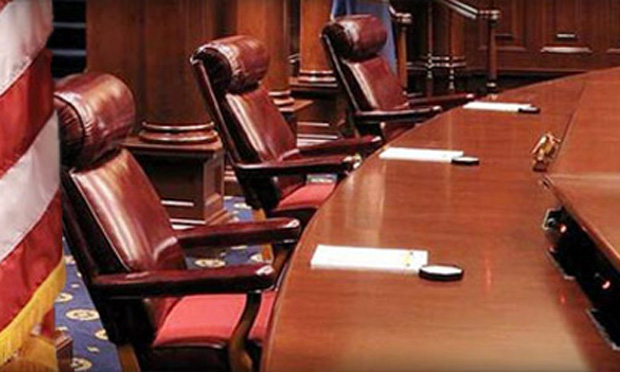In March 2015, the Supreme Court will hear yet another case that could have a significant impact on the Affordable Care Act — King vs. Burwell, which challenges the subsidies paid in states with insurance marketplaces run by the federal government. If the high court were to rule against the government, health insurance subsidies could be struck down in as many as 37 states, with up to 6.2 million people losing their tax credits. Beyond the specifics of this controversial case — and the many others in recent years — are growing questions about the politicization of the Supreme Court. One measure is the increasing numbers of cases decided by 5-to-4 votes, including the first Obamacare case, considered by some legal scholars to be among the most overtly political recent decisions and, perhaps unsurprisingly, also one of the most likely to be overturned.
While the U.S. public continues to view the Supreme Court more favorably than Congress or the presidency, opinions of the Court have broadly declined since the 1980s according to the Pew Research Center, reaching a record low in 2013. However, George Washington University found that the public sees the Supreme Court as “too mixed up in politics” while also favoring an appointment process that establishes candidates’ ideological views. The Pew Research Center found that views of the court were closely tied to people’s own ideology and what they perceived the ideology of the court to be. While lifetime appointments were meant to make justices immune to public opinion, the two appear to be intimately linked. The Court frequently attracts critics and defenders in Congress, depending on their partisan leanings and the issues at play.
A 2015 study, “The Politics of Selecting the Bench from the Bar: The Legal Profession and Partisan Incentives to Politicize the Judiciary,” examines the ideological positions of lawyers and judges across different tiers of the legal system. The authors, Adam Bonica of Stanford and Maya Sen of the Harvard Kennedy School, analyze data that captures the ideological position of nearly half a million judges and lawyers to document how and why U.S. courts are politicized. The data identifies campaign contributions and related “ideological common-space scores” for 377,427 lawyers in private practice, 3,966 law professors, 2,726 government attorneys who make up the judge candidate pool, and 11,115 state and federal judges. The data allows the authors to identify the political disposition of judges directly rather than relying on the identity of the politicians who appointed them. (The results are broken down by state, though it is worth consulting the scholars for interpretations of the data.)
The study’s findings included:
- Compared to the general U.S. population, attorneys are on average politically left-of-center. However, female lawyers, public defenders and law professors are all more likely to be liberal-leaning, whereas lawyers working for large law firms are more likely to be conservative. The results also show increased conservatism as more time passes after bar admission.
- The ideological distribution of judges is markedly to the political right of lawyers. Further, the higher in the judicial hierarchy, the more the political views differ. The most conservative courts (and therefore those least representative of the ideological distribution of lawyers) are the Federal Courts of Appeals, state high courts, federal trial courts and state trial courts.
- Evidence for the politicization of the courts is consistent at the federal level, less so at the state level: Courts in 24 states showed some politicization, while there was insufficient evidence for 26.
- While judges are generally more conservative than the states’ attorneys, they remain closer in their political ideology to attorneys than to politicians — suggesting there is capacity for even further politicization. The exception is in Virginia, the only state to select judges exclusively through legislative election.
- Greater politicization at the federal rather than state level may indicate strategic action by conservatives and Republicans to funnel the most viable candidates toward higher courts, where decision-making is more politically important. Given that there are far fewer conservative attorneys, the pool of viable candidates is therefore smaller. However, the authors find evidence that strategies such as the 1982 creation of the Federalist Society in U.S. law schools to foster conservative legal talent may be paying off: Graduates of elite law schools who went on to become judges are far more likely to be conservative than their peers.
- Given the less-conservative nature of U.S. attorneys, even in a nonpoliticized judiciary you would expect to see a higher proportion of less-conservative judges. However, in the federal courts and many state courts the reverse is true. Furthermore, that the shift in ideological makeup between attorneys and judges is greater high up in the judicial hierarchy suggests strategic action on the part of conservatives.
In concluding, the authors caution against making absolute generalizations: “We note that politicization is perhaps not as pervasive as some have feared, at least not when we compare across all 50 states. Although we see strong evidence of politicization in the federal courts and also in state high courts, many states exhibit little to no signs of politicization. Given that conservative political actors may stand to benefit from increased politicization, this leaves some questions unresolved.”
Related research: The Brennan Center for Justice at New York University Law School continues to monitor the issue of money and judicial elections. For more on how new campaign finance laws may reshape the courts, see the 2014 report “After Citizens United: The Story in the States.”
Keywords: Supreme Court, Obamacare, judiciary, judicial branch


Expert Commentary